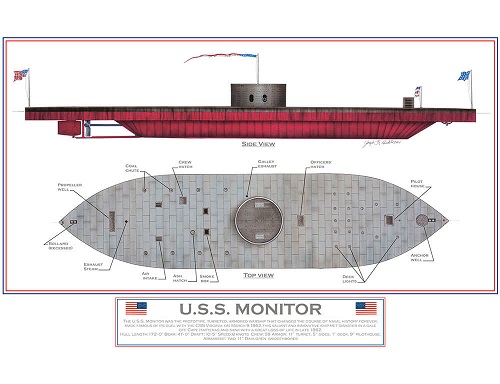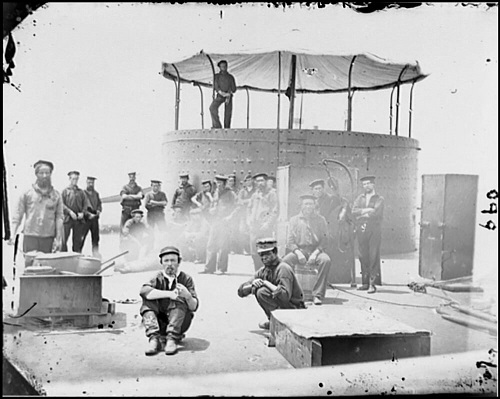
Fifty years ago, on August 27, 1973, scientists from Duke Marine Laboratory made a heart-stopping discovery 240 feet deep in the Atlantic Ocean.
A team of scientists led by John G. Newton, marine superintendent for the oceanographic program at the Duke Marine Laboratory, were testing geological survey equipment in the Atlantic. Specifically, they planned to map an area of the continental shelf off the North Carolina coast, but they also wanted to test the equipment’s usefulness for underwater archaeology. They decided they would look for the shipwrecked Monitor, a legendary Civil War ironclad that sank off the coast of Cape Hatteras in 1862.
The great shipwreck’s exact location was unknown for 111 years, but that was not for lack of trying to find it. People had been looking for the Monitor for decades and claimed to have seen it, but nothing was ever conclusive. In fact, in 1973, seven different groups descended on the ocean waters to search for the Monitor.
Photo above: Recovering the turret from the USS Monitor in 2002. The ship's guns, the remains of two crewmen and numerous artifacts were recovered with the turret. Photo History of the USS Monitor |

Photo above: A diagram of the USS Monitor USS Monitor | Monitor National Marine Sanctuary (noaa.gov)
In August 1973, on board Duke University’s 100-foot research vessel Eastward, Newton’s expedition retraced the path of the USS Rhode Island, the sidewheel steamer that was towing the Monitor the night she sank. Using an 1857 survey chart and the Rhode Island’s logbook, the Eastward followed the ships’ route around Diamond Shoals.
At Diamond Shoals on New Year’s Eve in 1862 the Monitor began taking on water. En route to South Carolina to battle the Confederates, the powerful Rhode Island was towing the Monitor to make the journey faster. As the ships rounded Cape Hatteras, the winds increased to gale force and water washed into the Monitor through a leak in the turret. To avoid striking its tow ship, the Monitor’s commander ordered the tow lines to be cut. This was done, but the lines became entangled in the Rhode Island’s wheel, rendering that ship immobile. The Monitor’s anchor was dropped, but as it went down, the anchor well sprang a leak. With the ocean washing in, the Monitor’s crew sent up a red light signal, the sign that they were abandoning ship. Two lifeboats from Rhode Island came to rescue them, and the Monitor sank. Forty-seven men were saved, but 16 were lost.

Photo: Some of the crew on the deck of the Monitor. When it sank near Cape Hatteras on December 31, 1862, 16 men perished and 47 were saved. History of the USS Monitor | Monitor National Marine Sanctuary (noaa.gov)
Aboard the Eastward in 1973, Newton’s team painstakingly searched a 5-mile by 14-mile section of the Atlantic floor with sonar equipment, locating 21 wrecks, but none of them matched the Monitor’s description. On the last day of research, August 27, the sonar indicated a 22nd shipwreck discovery 16 miles south-southeast of Cape Hatteras Lighthouse. Lying in 220 feet of water, the shipwreck was difficult to study. The scientists dangled underwater cameras over the site, and the resulting images were promising but unclear. They could see that the ship was upside down and the hull resembled the Monitor’s. They could also detect a circular structure that resembled the ship’s turret.
In March 1974, Newton announced to the world that he had found the USS Monitor. But there were still skeptics. So in April of 1974 Newton and a research team went back to the site to verify the find. Aboard the sophisticated Navy Alcoa Seaprobe, a vessel designed for deep-ocean exploration and recovery, the team had access to better equipment. They gathered more than 1,200 photographs, several hours of videotape and a photomosaic that proved without a doubt that this was the Monitor. Then came the question of how to protect it. The ship lay outside of U.S. territorial waters and was not longer owned by the Navy. It was in 240 feet of water, which is accessible to technical divers looking for artifacts.
On January 30, 1975, the Monitor and the column of water surrounding it, 1 nautical mile in diameter, were named as the first U.S. National Marine Sanctuary. The National Oceanic and Atmosphere Administration manages the sanctuary, focusing on the recovery of artifacts and protecting the shipwreck site from anchors, fishing and diving. The site is closed to diving except by federal permit. The Monitor, which is also on National Historic Register and is a National Historical Landmark, is living out its days on the ocean floor as a protected haven for marine life.
In recognition of the 50th anniversary of discovering the Monitor, confirmation of its location in March 1974 and the establishment of the National Marine Sanctuary in 1975, NOAA is hosting events that retell this history. John Broadwater, president and founder of Spritsail Enterprises and former superintendent at Monitor National Marine Sanctuary, led a webinar about the 1973 discovery of the Monitor on August 31, detailing the history of the discovery and his involvement (he dove on the site more than a dozen times). More events will follow in the upcoming year.
The Mariners’ Museum in Newport News, Virginia, is the official repository for the collection of artifacts that have been collected from the Monitor site. The collection contains the priceless artifacts recovered from the ironclad. The museum is open to the public and the exhibit “Ironclad Revolution” has artifacts, documents, paintings, personal accounts, interactive exhibits and more about the Monitor. The turret and guns from the ship are also on display. The Graveyard of the Atlantic Museum in Hatteras is currently closed for updated exhibits and renovations, but when it reopens in early 2024 it will have an exhibit on the Monitor.

Priceless artifacts recovered from the Monitor are on display at the Mariners' Museum in Newport News, Virginia.
To learn more about the storied history of the USS Monitor and the Monitor National Marine Sanctuary, click here. To hear John Broadwater's August 31 presentation on the discovery of the Monitor in 1973, click here.


 Molly Harrison is managing editor at OneBoat, publisher of OuterBanksThisWeek.com. She moved to Nags Head in 1994 and since then has made her living writing articles and creating publications about the people, places and culture of the Outer Banks.
Molly Harrison is managing editor at OneBoat, publisher of OuterBanksThisWeek.com. She moved to Nags Head in 1994 and since then has made her living writing articles and creating publications about the people, places and culture of the Outer Banks.

